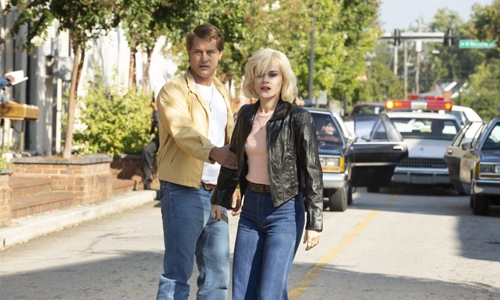‘Finding Steve McQueen’ is a likable, thin, crime drama
Finding Steve McQueen is a 2019 American heist thriller film directed by Mark Steven Johnson and written by Ken Hixon and Keith Sharon. The film stars Travis Fimmel, Rachael Taylor, Forest Whitaker, and William Fichtner, telling the story of a gang planning to steal millions of dollars from President Nixon’s illegal political slush fund. It was released in the United States on March 15, 2019, by Momentum Pictures.
The film is based on the United California Bank robbery. Finding Steve McQueen starts in 1980, when Barber (Travis Fimmel), a stammering good-natured hunk with bright blue eyes, comes clean to his girlfriend Molly Murphy (Rachael Taylor) about his real identity after seeing his face on an FBI Most Wanted poster. He’s been on the lam for 8 years after robbing a bank in 1972, and he’s been operating under an assumed name ever since.
The two sit in a diner, and he tells his story, launching the narrative back to 1972 when it all began. The heist movie has a long pedigree, and while “Finding Steve McQueen” is no “Le Cercle Rouge” or “Rififi” (or even “Reservoir Dogs”), Johnson keeps the tone light, vivacious, almost slapstick at times. This is a smart choice. The movie could have taken itself very seriously, bogging itself down in political commentary.
Instead, there’s a loose vibe, and some humor in the culture clash of roughneck Ohio guys circulating in anything-goes California, gobsmacked by the hot tubs and hot chicks. Enzo (William Fichtner) is the mastermind, sleazy and smart, and so angry about Vietnam his rage quivers through his body when he talks about it. Enzo loops his nephew Harry into the scheme since Harry is known to be hell on wheels (the real Harry Barber apparently got 41 speeding tickets in one year).
Harry drives a 1969 Mustang GTO, modeling himself after Steve McQueen in “Bullitt” (although Bullitt drove a 1968 Ford Mustang). At one point, Harry is seen in a pose mirroring Steve McQueen’s in the famous “Bullitt” poster. Opposite all this activity is the FBI investigation, led by agents Howard Lambert (Forest Whitaker), and Sharon Price (Lily Rabe). Two pioneers in their field, he as an African-American, she as a woman, they both have a desire to prove themselves, and there are all these weird mournful layers to their interactions (his marriage is in trouble, she seems to have a crush on him).
This is an eccentric choice, but it works. (“Finding Steve McQueen” works best when it embraces eccentricity.) Whitaker and Rabe create a believable vibe of two melancholy loner workaholics, bonding together, treating each other with care as they try to solve the case. The pop culture talk among the thieves is stifling, each reference like an arrow pointing to the year, as though everyone in 1972 sat around talking about Sally Struthers, Mod Squad and Richard Bach 24/7. The music falls into a similar Greatest Hits of 1972 trap.
There’s one car chase early on in “Finding Steve McQueen”, when Harry flees from a police car through a quarry, and except for a couple of graceful overhead shots, the scene points up how car-chase execution in film is practically a lost art. This wouldn’t matter so much except that “Bullitt” is still known for its awe-inspiring car chases, and Harry is such a gearhead, we want to see more of it.
Related Posts

